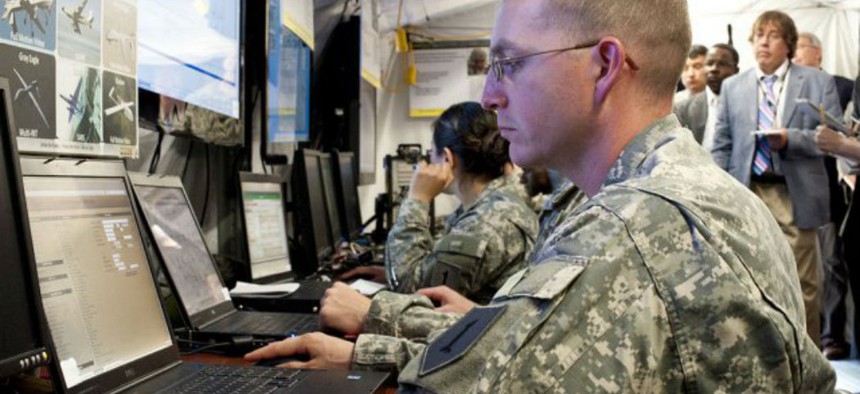Army protects next generation navigation technology from cyber attacks
Military leaders discussed the progress and urgency of pursuing cyber security readiness at AFCEA’s Army IT Day.
Next generation position, navigation, and timing (PNT) technology that will be less vulnerable to cyber attack is scheduled to reach operational assessment early next year, according to Maj. Gen. Wilson Shoffner, Director of Operations at the Army Rapid Capabilities Office (RCO), speaking at the 16th Annual AFCEA Army IT Day, hosted by the Northern Virginia chapter of the Armed Forces Communications and Electronics Association (AFCEA).
“We…provide a navigation, positioning and timing kit to give the ability to navigate in a contested environment,” explained Shoffner at the event. “The first project is actually underway and we hope to start the operational assessment of that kit in early 2018.”
The latest PNT technology, being developed through DARPA and the Army Emerging Technologies Office, will no longer depend on GPS technology, which requires sending and receiving signals to satellites and therefore can be disabled by electromagnetic and cyber space interference.
Instead, the new PNT systems will rely on cold-atom interferometry technology reinforced when possible by long distance commercial electromagnetic waves, such as those emitted by televisions, or naturally occurring ones, such as those emitted by lightning strikes. According to DARPA, Hardware technology allows a cloud of atoms to be encapsulated in a sensor pod, while software algorithms measure the motion of these atoms in order to determine location and time.
Other emerging cyber defense technologies are being included in upgrades to the Deployable Mission Support Systems (DMSS), according to said Brig. Gen. Maria Barrett, Deputy Commander for the Cyber National Mission Force (CNMF) of the U.S. Cyber Command, also speaking at AFCEA’s Army IT Day.
The DMSS are reconnaissance, security and counter-mobility kits tailored to the needs of each service and are on the brink of full operational capacity, according to Barrett. Cyber Protection Teams act as their current service providers.
The latest adjustments to these cyber security kits, she announced, will allow for more split-base operations, guidance for operators on technology-specific software, and a focus on analyzing sensor data for use in offensive operations.
“The Cyber Mission Forces today are engaged in over 50 U.S. Army operations,” said Brig. Gen. Maria Barrett, Deputy Commander for the Cyber National Mission Force (CNMF) of the U.S. Cyber Command. “We now turn our attention to how to sustain this readiness of the cyber mission forces and…making sure that they have the capabilities they need to execute the mission.”
Other hardware and software improvements for tightening cyber defense were described by Brig. Gen. Patrick Burden, Executive Officer of Enterprise Information Systems (EIS) Program, including network modernization and consolidating the enterprise computing environment. According to Burden, the goal is to reduce the number of data centers, and consolidate and transfer the software applications being run by the centers.
“We [PEO EIS] build, deploy, support, and sustain the global network that connects the Army and its mission partners,” explained Burden. “By leveraging commercial-off-the-shelf-technologies, industry standards, and industry best practices.”
Another theme of the day was speed. Barrett discussed CNMF’s work to push cyber technology into the field at the initial operational capacity stage in order to identify necessary improvements early on. While Shoffner spoke on his office’s rapid acquisition model of field testing multiple new technologies at once, identifying the most effective ones, and only pursuing those to full operational capacity.





